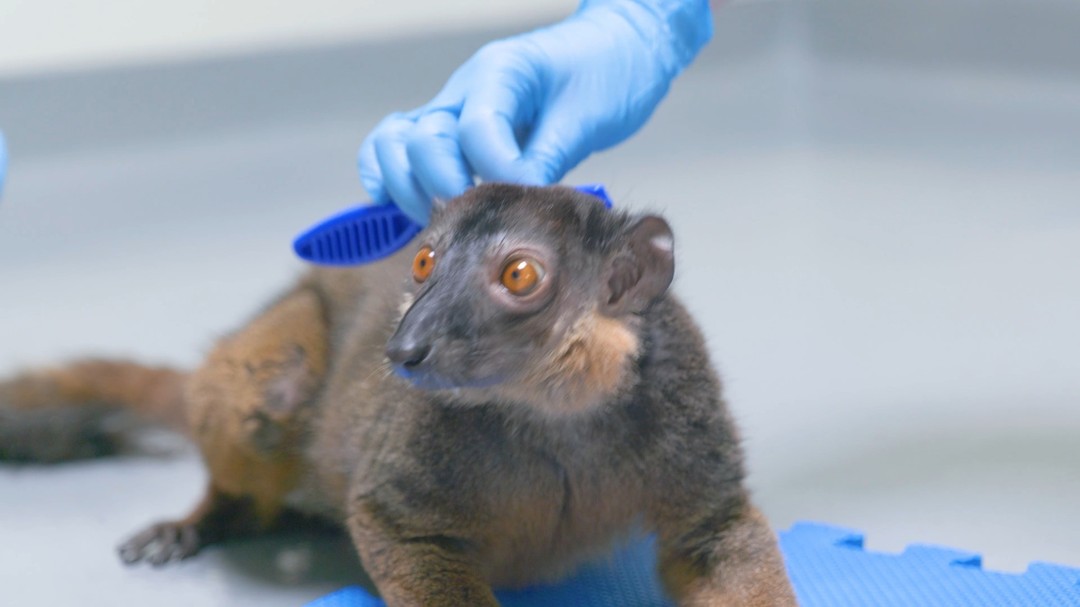– The social dynamics and importance of companionship in lemur species
– The impact of losing a mate on a lemur’s physical and mental health
– Innovative care strategies in zoos: human caregivers as surrogate companions
– Ethical and practical considerations in animal husbandry
– The role of enrichment programs and prospects for solitary lemurs in captivity
Lemurs, native to Madagascar, are some of the most remarkable primates on earth. These engaging creatures are not just known for their distinctive looks and lively antics but for their complex social structures and behaviors. Among these, the Red-collared Brown Lemur, a species renowned for its vibrant social life, stands out. The Aquarium’s recent loss of Jessie, a female of this species, has been deeply felt, not least by her mate, John. The absence of a companion for a lemur can have profound and multifaceted effects. This situation has led the Aquarium’s lemur care team to innovate a compassionate and experimental care program, stepping in to fulfill John’s role as a social partner, including the critical grooming behavior, until a new companion is found.
In the wild, lemurs exist within intricate social networks, where interactions such as grooming are essential for maintaining relationships and hierarchy. This physical bonding exercise, known as allogrooming, is not purely for cleanliness; it’s a cornerstone of lemur society, vital for emotional well-being and social attachment. Grooming helps lemurs build alliances and reduces stress, playing a role in the collective health of the group. For solitary lemurs like John, the absence of these interactions can lead to depression, anxiety, and other health issues. This absence presents a significant challenge for the Aquarium’s care team.
Losing a mate has tangible repercussions on a lemur’s physical and mental state. John’s case is no exception. These primates experience loss profoundly. They can become less active, lose their appetite, and show signs of distress. To prevent such decline, the care team has instituted a program mirroring natural lemur interactions. Caregivers have embraced the role of grooming partners, using soft brushes and gentle techniques to mimic lemur grooming behaviors. This serves to maintain John’s coat and provides the emotional support he would typically receive from his species.
This unusual approach raises intriguing questions about animal husbandry. Zoo and aquarium staff must balance intervention against the animal’s well-being. Establishing human surrogates is a sensitive matter grounded in an in-depth understanding of lemur psychology and social needs. It’s critical that these interventions are carefully monitored to ensure they comfort the animal without causing confusion or undue stress.
The concept of human caregivers as surrogate companions extends beyond grooming to encompass overall companionship. Caretakers engage with John in ways that stimulate his natural behaviors. This form of enrichment—a standard practice in zoological settings—is especially critical when animals are suffering of conspecific interaction. The goal is to keep John physically active, mentally stimulated, and socially engaged until he can be reintegrated with another lemur.
Looking forward, the best solution for John would indeed be the introduction of a new lemur companion. However, this is not a process that can be rushed. It requires finding a suitable match for John based on temperament, age, and social compatibility. In the meantime, caregiving staff must continue their innovative surrogate roles, ensuring John’s comprehensive needs are met. The success of this program could have ramifications for the management of other solitary animals in zoos worldwide, influencing future animal husbandry practices.
While the interaction between John and his human caregivers is a remarkable example of adaptability in the face of loss, it is a situation ideally resolved by finding him a new lemur mate. Until then, the Aquarium’s efforts serve as a testament to the dedication necessary to maintain the welfare of animals in human care. The tale of John the Lemur illustrates the intersection of conservation efforts, captive animal well-being, and the complexity of mitigating the impacts of solitude on social species, highlighting the evolving nature of wildlife conservation and management.
*****
Source Description
Early this year, the Aquarium lost its female Red-collared Brown Lemur, Jessie, leaving her mate, John, without a companion of his species. Lemurs are highly social animals, and grooming, in particular, is more than just a matter of hygiene but a crucial component of their social interaction.
Until a new companion can be found for John, the Aquarium’s lemur care team has undertaken an experimental training program to let THEM serve as surrogate “lemurs” and groom John to help him cope with his loss and receive the socialization he desperately needs.

